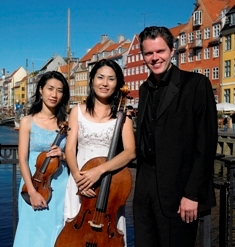
Trio con Brio Copenhagen One for the Season
Haunted
houses, tales from the crypt, monster mashes.
There’s a lot of Halloween fare to choose from this time of year, musical
and otherwise.

Whether they knew it or not, Trio con Brio Copenhagen was right in tune Tuesday evening (October 26) in Werner Recital Hall at the University of Cincinnati College-Conservatory of Music.
It wasn’t
just Beethoven’s “Ghost” Trio that did the trick. You could
find linkage in Tchaikovsky’s Piano Trio in A Minor, R.I.P. Nicholas Rubenstein, and even Danish composer
Hans Abrahamsen’s 2009 “Traumlieder” ("Dream Songs").
Presented by Chamber Music Cincinnati, the award-winning Trio, recipient of the 2005 Kalichstein-Laredo-Robinson International Trio Award, treated their listeners to a remarkable and rewarding demonstration of their prowess, individual and otherwise. Danish pianist Jens Elvekjaer, violinist Soo-Jin Hong and cellist Soo-Kyung Hong (both natives of Korea), are an ensemble in the truest sense of the word, a unity whose combined music-making tempts the word “perfect.”
They opened
with Abrahamsen’s “Traumlieder," an arrangement of his 1984 “Six
Pieces for Horn, Violin and Piano” in its Midwest
premiere. The composer’s biography describes
him as a product of the1960s “New Simplicity” movement in
Denmark, which emphasized clarity in reaction to the complex,
mid-century modernism then in style. His music has evolved through “poetic” (romantic)
to organic and inclusive, with continuing emphasis on structure. This does not necessarily mean easy to listen
to (or apprehend). In remarks before the performance, pianist
Elvekjaer noted that the third movement of the “Traumlieder,” “Scherzo
misterioso” has a structure that may be simple, i.e. tone rows that intersect
and interact by design, but incomprehensible to the ear.
The six movements are brief and bear evocative titles. “Serenade” was counter-intuitive: soft, halting and astringent. “Arabesque” sped by, with repeated violin rhythms and a furious buildup that quickly evaporated. “Blues” briefly evoked Gershwin’s Piano Preludes. "Funeral March" exploded, with intense vibrato and snap pizzicato by the strings. Engines raced in the Scherzo, while the final movement, “For Children” grew ethereal, ending with a piano melody and a high, long-held harmonic by the violin.
Beethoven’s Op. 70, No. 1, dubbed “Ghost” -- but not by Beethoven -- got its name because sketches for the slow movement were found among his notes for an opera based on Shakespeare’s “Macbeth” (the opera was never written). Witchy or not, the second movement, Largo assai ed espressivo, is dark and brooding, with spooky tremolos by the strings. The opening Allegro vivace e con brio, is brighter, taking off in a rush of energy before laying down the movement’s thematic materials. The Presto finale is brighter still, even merry, and brought the work to an optimistic conclusion.
Trio Copenhagen performed all of this with extraordinary precision. Communication among the three musicians was amazing, and one felt that they thought, moved and even breathed together, irresistibly drawing the listener in. (The Trio is a family, by the way. Soo-Jin and Soo-Kyung are sisters and Soo-Kyung is married to Elvekjaer.)
Tchaikovsky’s Piano Trio, subtitled “To the Memory of a Great Artist,” is only two movements, but close to 50 minutes long. The first he called Pezzo elegiac (“Elegiac piece”). The second is a Theme and Variations with a two-pronged ending: Variazioni Finale e Coda, marked Allegretto risoluto e con fuoco (“resolute and with fire”) and Andante con moto -- Lugubre (“mournful”).
If this sounds programmatic, it is. Tchaikovsky wrote the Trio following the death of his friend Nicholas Rubenstein, pianist and director of the Moscow Conservatory. The Variations supposedly refer to a day the two men spent in the country, and each of the 11 Variations, rather like Elgar’s “Enigma” Variations, marks some aspect of Rubenstein’s life or career (Tchaikovsky did not elaborate further).
The Trio is
not heard that often. For one thing, it
is extremely difficult for the pianist, having been written in homage to a great
pianist (Rubenstein). Elvekjaer showed
his mastery here, dispatching thickets of notes with apparent ease and aplomb. At the same time, he refrained from
dominating the ensemble and worked in total concert with the other two instruments.
The Elegy was passionate and heroic, with some tricky staggered rhythms. Violinist and cellist, elegant in green and purple gowns, respectively, worked together to create a seamless fabric. This was spellbinding at the end where the instruments echoed and intertwined with each other. The Variations -- on a folk-like, but original theme by Tchaikovsky -- were finely crafted miniatures. Particularly notable were the charming, quicksilver Variation No. 3 (piano with pizzicato strings), the very Russian sounding No. 4 (was Rachmaninoff inspired by this?), the heroic No. 7 (big piano chords with flourishes by the strings), the plaintive (flebile) No. 9, and a flashy Polish Mazurka, No. 10.
The Variazioni Finale, extended variations on the same theme, followed a triumphant, almost giddy, course, suddenly cut short by the return of the Elegy theme. The final Andante con moto was a triple-forte study in grief, capped by a soft ending (Lugubre) whose rhythms recalled the famous funeral march from Chopin’s B-flat Minor Sonata.
Next up for Chamber Music Cincinnati is the Harlem Quartet at 8 p.m. Dec. 7 in Werner Recital Hall at CCM. Their program comprises Beethoven, Zaimont, Strayhorn, Borodin and Corea. Information at www.cincychamber.org or call (859) 581-6877.